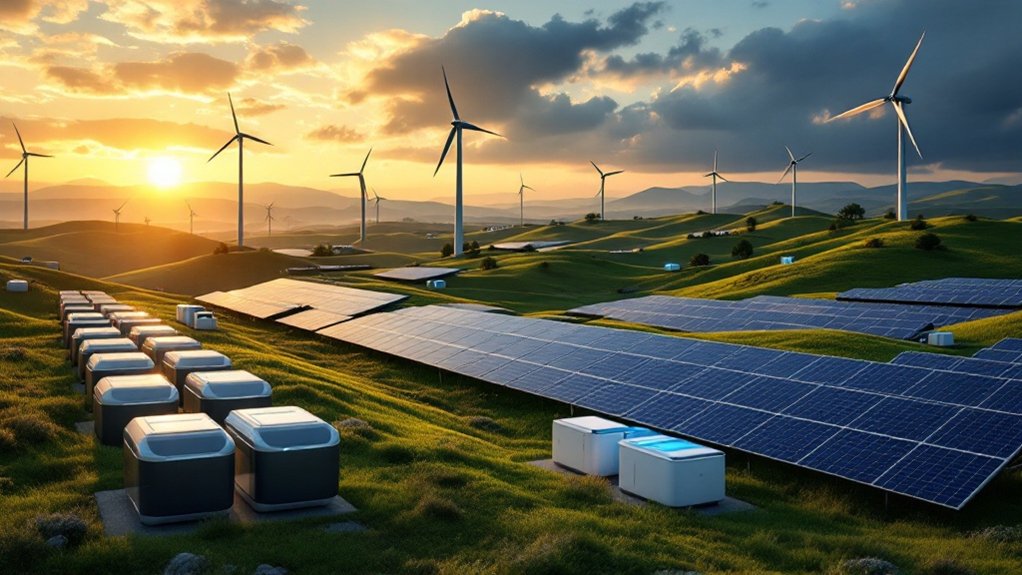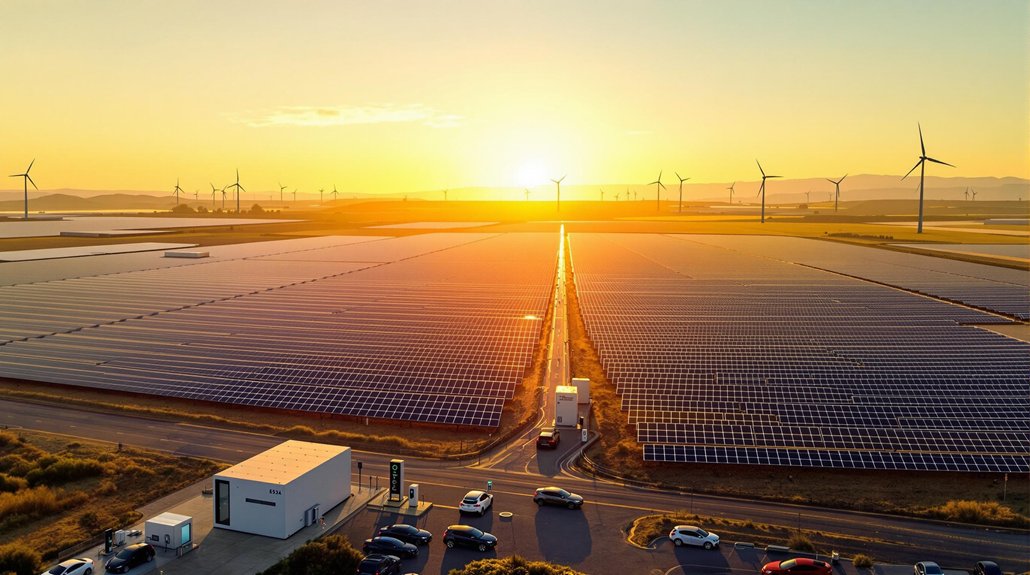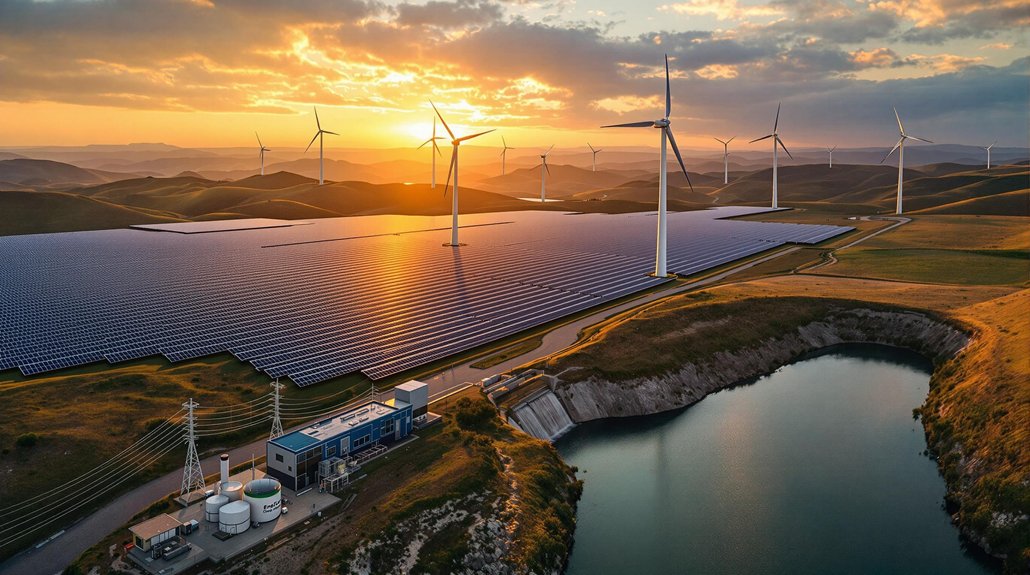Renewable energy is growing fast, with solar expected to provide half of global electricity by 2050. EV sales jumped 25% in 2024, while battery costs have fallen below $100 per kilowatt-hour. Energy storage nearly doubled to 170 gigawatt-hours this year, helping solve renewable intermittency issues. Government policies like the US Inflation Reduction Act are driving investment. These trends point to a dramatic transformation of our energy landscape.

As the world shifts toward cleaner power options, renewable energy technologies are experiencing unprecedented growth across multiple sectors. Solar energy capacity is projected to reach nearly 863 gigawatts in the coming years. This expansion isn’t slowing down, with experts predicting solar will provide half of global electricity by 2050.
In 2022 alone, the world produced 1.5 billion solar panels, a 57% jump from the previous year.
Electric vehicles are gaining ground quickly. EV sales grew 25% in 2024, with more than, 16 million vehicles sold worldwide. China leads this evolution, with over half of all new cars sold there being electric since July 2024.
Battery costs have fallen below $100 per kilowatt-hour, making EVs competitive with gas-powered vehicles. Price parity is coming soon for most markets—Europe by 2025, the US by 2026, and India by 2027.
Money is following this clean energy boom. The renewable energy market reached $189.5 billion in 2022 and could grow to $607.8 billion by 2030. Investment in renewables now outpaces fossil fuels by 10 to 1, with solar attracting more funding than all other power sources combined.
Energy storage is solving the intermittency problem. Grid storage nearly doubled to 170 gigawatt-hours in 2024. Modern batteries use less than half the nickel and cobalt they did a decade ago. Research teams are analyzing how energy transition implications affect everything from industrial processes to power distribution systems.
Current commercial solar panels operate at 17-20% efficiency, while researchers continue developing technologies approaching 50% efficiency. New technologies could double energy density in the next five years.
Government policies are accelerating this evolution. The US Inflation Reduction Act provides long-term tax incentives. The EU’s REPowerEU Plan and Green Deal Industrial Plan are driving solar investment. China’s Five-Year Plan sets ambitious renewable targets.
Technology improvements continue to drive costs down. Solar module prices fell 35% to 9 cents per watt in 2024. Advanced solar cells and green hydrogen production are scaling up.
Artificial intelligence is making renewable systems more efficient. This global energy shift is happening even faster in developing nations, with solar and wind scaling twice as fast in the Global South. Despite this impressive growth, renewables’ 30% electricity contribution still represents a fraction of total global energy consumption, highlighting the challenges ahead.
Frequently Asked Questions
How Much Does Transitioning to Renewable Energy Cost for Homeowners?
Homeowners typically pay $15,000-$25,000 for solar systems before incentives. A federal tax credit covers 30% of costs through 2032.
Additional state rebates can reduce expenses by $1,000-$5,000. Most systems pay for themselves within 7-10 years through utility bill savings.
System costs have fallen 60% in the past decade, making renewable energy more affordable for average households.
Can Sustainable Energy Meet Industrial Power Demands Reliably?
Sustainable energy can meet industrial power demands reliably with the right approach. Current grid reliability stands at 99.5% in the U.S.
Battery storage costs have dropped 89% since 2010. Smart grid technologies and diverse energy mixes enhance system resilience. Hydrogen fuel cells provide backup power options.
With continued investment in grid modernization and improved forecasting models, industries can depend on renewable sources while meeting their high-volume electricity needs.
What Government Incentives Exist for Green Energy Adoption?
Government incentives for green energy adoption include federal tax credits like the 30% Investment Tax Credit for solar and wind projects through 2032.
The Production Tax Credit offers up to 2.6 cents per kilowatt-hour for renewable electricity.
States provide additional support through renewable portfolio standards and net metering policies.
Businesses can access specialized grants, while homeowners qualify for residential clean energy credits for solar installation and EV purchases.
How Do Weather Patterns Affect Renewable Energy Efficiency?
Weather patterns greatly impact renewable energy efficiency.
Solar panels lose output in high temperatures, with efficiency dropping 0.3-0.5% per degree Celsius increase.
Wind energy suffers during wind droughts and extreme winds over 55 mph force turbine shutdowns.
Hydropower depends on consistent precipitation patterns, with droughts reducing generation capacity.
Weather forecasting has become essential for renewable energy operations, helping operators anticipate fluctuations and optimize output during changing conditions.
When Will Sustainable Energy Achieve Grid Parity Globally?
Global grid parity for sustainable energy won’t happen simultaneously.
Many developed countries have already achieved it for solar and wind in specific regions. Experts predict most developed nations will reach widespread grid parity by 2025-2030, with developing countries following 5-10 years later.
Full global parity is expected around 2035.
Challenges include grid infrastructure needs, intermittency issues, and fossil fuel subsidies that distort markets.









